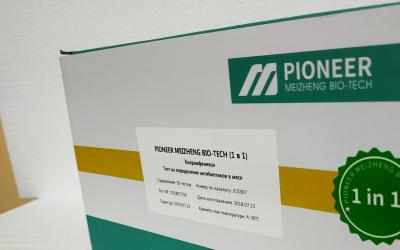An agricultural cluster worth 4 billion rubles is being created in Buryatia

In Buryatia, the implementation of a large interregional investment project in the field of agriculture begins. The project will simultaneously give the region several socio-economic effects.
The idea of creating a livestock cluster in Buryatia was presented to industry experts and federal agencies at the IV International Agricultural Exhibition AGROS-2023 in Moscow.
Momentum for farming
The project was developed by the Khabarovsk company Myasopttorg. The volume of investments is estimated at 4 billion rubles. The capacity of the complex is designed for 9 thousand slaughter heads of cattle per year. The complex will be built on the principle of a closed cycle: from growing fodder crops, MEAT production and processing to the sale of finished products. In addition to the farm, a feedlot, a fodder preparation shop, a slaughter shop, waste processing, fodder and grazing units will be built on the territory of the complex.
There are also plans to build a high-tech beef and lamb processing plant. The facilities will be located on a plot of 50,000 hectares. Construction will begin this year, and the complex will reach its full capacity in 2033.
When implementing the initiative, the investor uses several tools. First, the active involvement of farmers in cooperation. The company will buy bulls from them for fattening and slaughter. General DIRECTOR of Myasoopttorg Yevgeny Shestyuk intends to collect a pool of at least 30 farmers. According to his idea, small enterprises will be engaged in programs to increase the productivity of the herd.
“We intend to concentrate on breeding cattle of the Kazakh white-headed breed,” says the entrepreneur.
Cluster as a center of growth and cooperation
The Government of Buryatia considers farming as one of the key agricultural priorities: in comparison with large-scale agricultural production, the farming business is distinguished by its flexibility and ability to quickly respond to consumer needs.
Today, more than one and a half thousand farms are registered in Buryatia, and their number is constantly growing. The cluster project will further strengthen the farming segment. Yevgeny Shestyuk intends to cooperate both with farms that already have their own farm, and with start-up entrepreneurs.
“The agrocluster meets the goals of the beef cattle breeding development strategy in our region. This will bring the development of farms to a new level and get a synergistic effect,” said Minister of Agriculture of the Republic of Buryatia Galsan Dareev.
Moreover, the stake is not only on the farmers of Buryatia, but also of the Trans-Baikal Territory, where cattle breeding is also highly developed. This will create cooperative chains between the livestock farms of the entire macroregion.
The development of the agrarian sector of the Republic of Buryatia, however, as well as the whole country, is holding back the outflow of young people. When creating an agricultural cluster, a tool was laid that partially solves this problem as well. The investor intends to support start-up farmers. According to Yevgeny Shestyuk, young specialists with specialized education will receive technical and financial resources to create farms for 100-150 heads of cattle.
According to industry experts, the idea is promising. The creation of an agrocluster will allow uniting small industries and creating a single production chain on this basis. The agro-industrial sector of Buryatia, to which the HEAD of the republic Alexey Tsydenov pays special attention, is one of the socially significant sectors of the economy of the Republic of Belarus. The contribution of the agricultural cluster to the gross regional product is estimated at 7%, the sector provides about 8% of employment in the republic.
New formats help to strengthen the position of the industry, and perhaps this experience will be disseminated in other regions of the Far Eastern Federal District.
Read together with it:
- Цифровизация агрострахования: как новые технологии снижают мошенничество в отраслиС 2022 года данные методы начали активно применять правоохранительные органы при рассмотрении обращений аграриев о помощи в экстренных ситуациях. Анализ показывает, что количество судебных разбирательств по вопросам агрострахования с государственной поддержкой значительно снизилось, что подтверждается недавними показателями: в 2......
- "Истинный полешук" Русый рассказал, как нарушил стиль работы на совещании у ПрезидентаМихаил Русый 18 ноября, Минск. Александр Лукашенко 18 ноября собрал совещание по темам развития районов Припятского Полесья и реализации соответствующей программы. Основным докладчиком на мероприятии выступил Михаил Русый - "истинный полешук", как назвал его Президент, уполномоченный представитель главы государства в Брестской области и председатель Постоянной комиссии по законодательству и госуда...
- Ученые Беларуси разработали новый ветеринарный препарат для лечения заболеваний крупного рогатого скотаНовый препарат, названный «Антипестивир-ВД», стал первым противовирусным средством на рынке, эффективным против болезней слизистых у коров, включая скрытые формы инфекции. В состав препарата входят компоненты, произведенные из местного сырья, которые активируют иммунный ответ животного. На этапе клинических испытаний препарат продемонстрировал высокую эффективность: 63,3% животных выздоровели в те...
- MGAP ужесточает контроль после обнаружения остатков эктопаразитицидов в говядинеМинистерство животноводства, сельского хозяйства и рыболовства ( MGAP ) через Главное управление животноводческих служб ( DGSG ) издало Постановление № 311/2025, которое устанавливает в качестве серьезного или очень серьезного правонарушения обнаружение остатков эктопаразитицидных ветеринарных препаратов у крупного рогатого скота , предназначенного на убой, в количествах, превышающих установленные...
- Чили: ChileMEAT предупреждает об убытках более чем в 6 миллиардов долларов из-за остановки производства говядиныЧилийская ассоциация мясоперерабатывающих и холодильных предприятий (ChileMEAT) выпустил официальное предупреждение, выражающее глубокую обеспокоенность критической ситуацией в южной части страныКризис стал результатом 15 дней непрерывной мобилизации должностных лиц, объединенных в Национальную ассоциацию должностных лиц сельскохозяйственной и животноводческой службы (Asfusag) , что привело к полн...
- Спрос на мясо в США останется высоким до 2026 годаВ интервью Valor Agregado на Radio Carve Мартинес отметил, что сейчас все с нетерпением ждут, что в конечном итоге произойдет в отношениях североамериканской страны с Бразилией и Аргентиной в связи с возможным снижением тарифов и дополнительной квотой в 60 000 тонн соответственно. Что касается дополнительной квоты Аргентины, которая увеличивается с 2......





























































